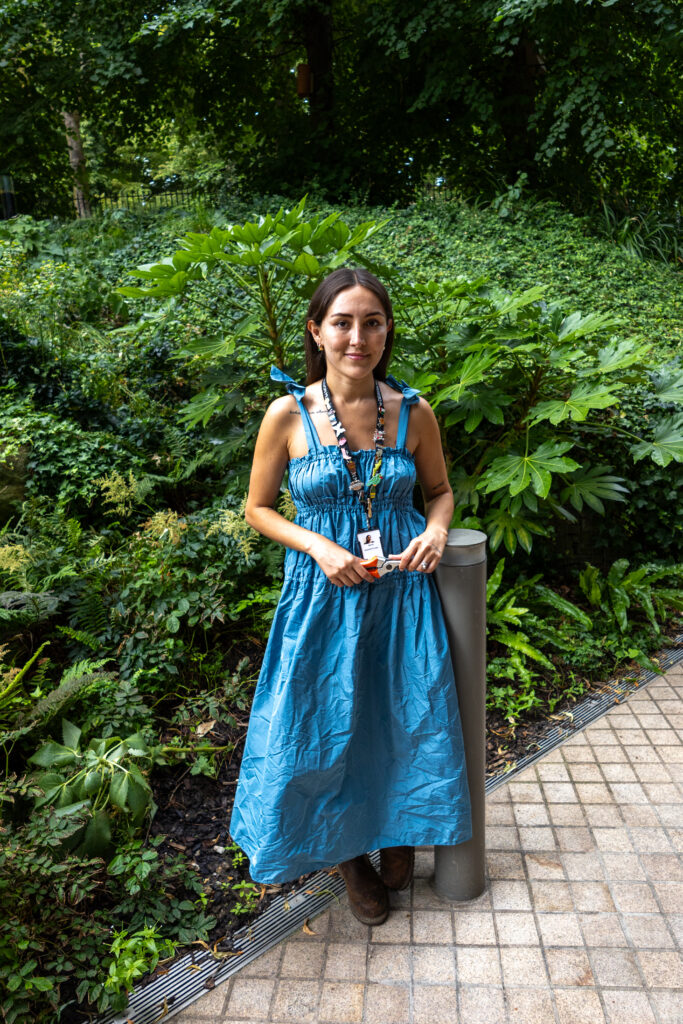We met with Naomi Zaragoza, Assistant Curator of Public Practice at the Design Museum. Part of the Learning team, she oversees public programming for temporary exhibitions, community projects, and access initiatives.

Our conversation took place in the Dame Sylvia Crowe Garden, where Naomi has led Growing Together, a three-year project exploring the intersection of design, gardening, horticulture, and wildlife in a once-abandoned space now transformed into a thriving community hub.
The Green Londoner: Naomi, could you tell us about your role at the Design Museum and how you became involved in the garden project?
I joined the museum two years ago as Assistant Curator of Public Practice. The Growing Together project had just started, and it naturally fell into my hands. Since then, I’ve been curating the programme alongside volunteers. When we began, the garden was almost bare — no flowers, no access to Holland Park, and it had been closed to the public until after the pandemic. Today, thanks to the community’s work, it’s full of perennials, textures, and shades of green that invite people to rest and reflect.
What makes the garden special for the community and visitors?
It’s a hidden oasis behind the museum. Neighbours, visitors, and volunteers come here to relax, enjoy nature, and sometimes take part in events. It’s not designed to be overly colourful — instead, the emphasis is on texture and calm. It’s a space where the museum’s community and the wider public can reconnect with the natural world.
One of the highlights is the Dwellings, Rehomed exhibition. Can you tell us about it?
Yes! Dwellings, Rehomed is a display of 17 birdhouses across the garden. It began with a collective called Computer Room, three designers who invited others to reimagine birdhouses. Originally, 21 houses were shown in a South London gallery. We selected eight from that collection and invited nine more designers to contribute new ideas. Some are highly functional, designed for specific species, while others are more conceptual and sculptural. Each has an interpretation label, and together they ask us to think about how we coexist with birds in shrinking urban habitats.
Will the birdhouses actually be used by birds?
That’s the exciting part — it’s an experiment. The birdhouses will remain in the garden for two years. Some may attract birds, others may not — birds can be territorial or selective about where they nest. We’ll observe how they’re used during nesting season in 2026, which will give us valuable insights into design and ecology.

Beyond birdhouses, what else is happening in the garden?
The garden is free and open during museum hours. It hosts three research projects: composting, natural dyes, and the scents of flowers in a changing climate and their impact on pollinators. It’s also a family-friendly space with insects, ladybirds, and butterflies to discover. Children love exploring here, and we created a printed booklet with activities as part of the More Than Human exhibition that opened in July — the birdhouses feature in the family trail.
What do you hope people take away from this project?
I hope visitors slow down, observe, and appreciate both the design and the wildlife. It’s about learning, cohabiting with nature, and seeing design not only as objects but as part of living systems. The garden proves that with care, creativity, and community effort, even a neglected corner can become a place of wonder.
More information about the Growing Together project and Dame Sylvia Crowe Garden is available on the Design Museum’s website.







